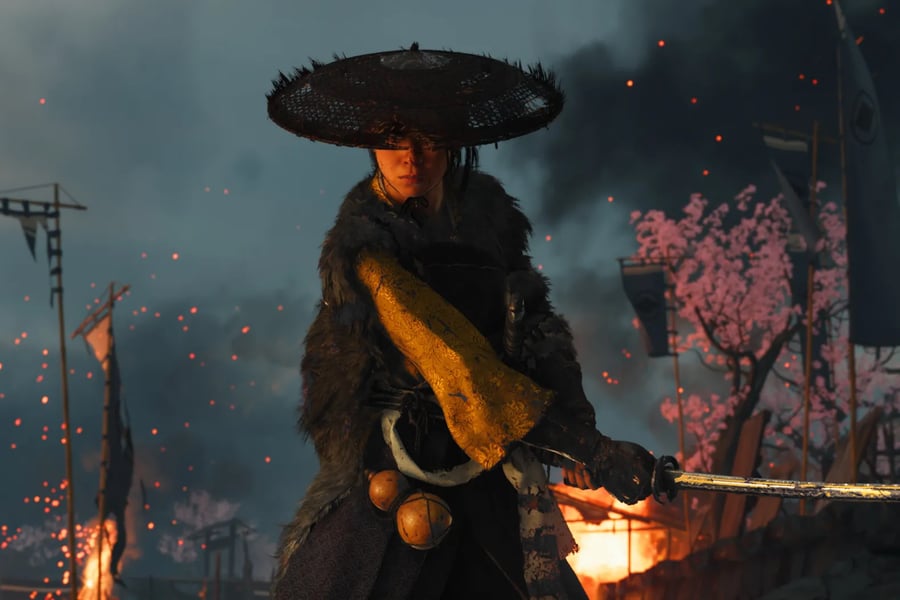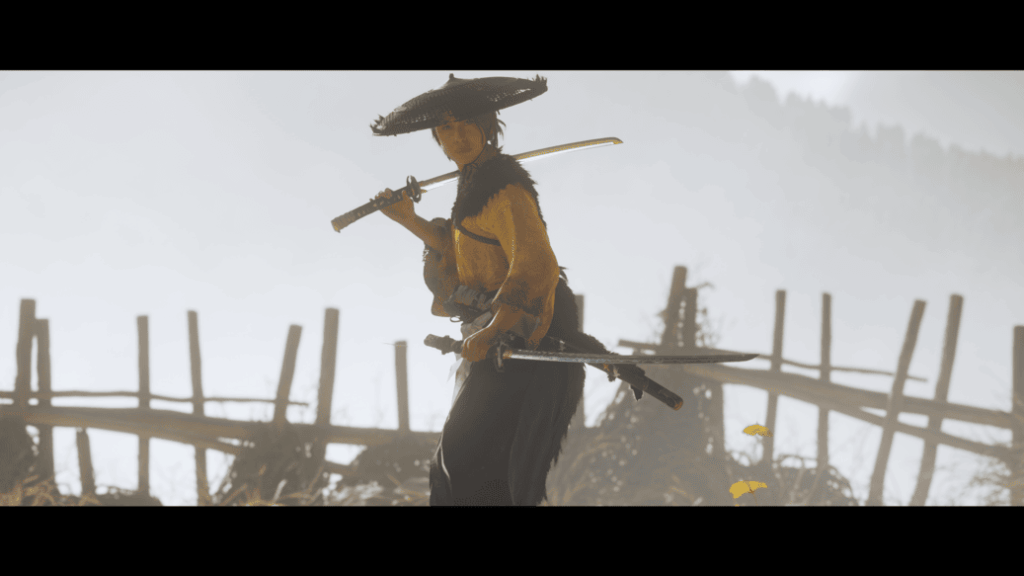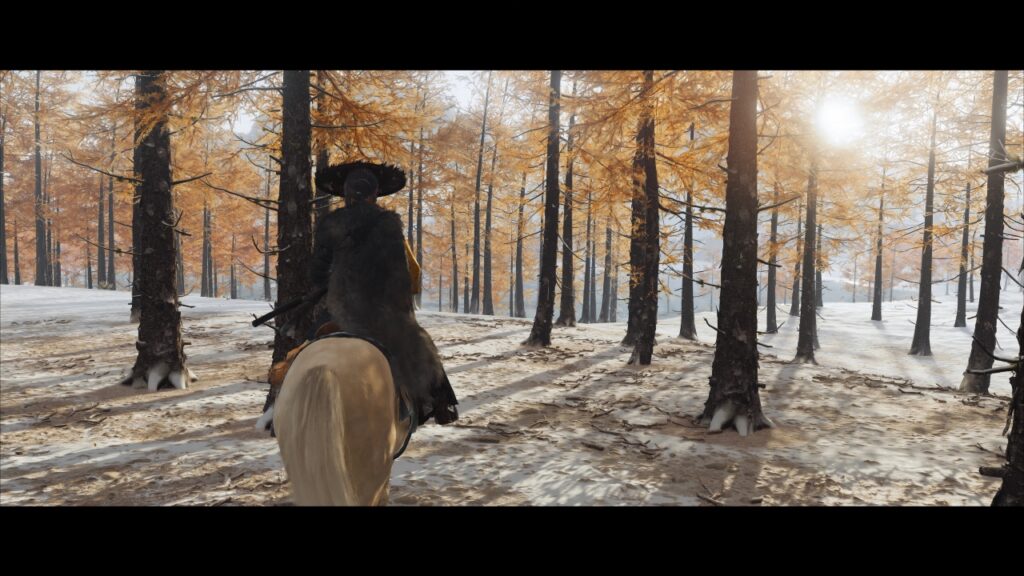When acclaimed gaming studio Sucker Punch first unveiled its ode to samurai culture, Ghost of Tsushima, in 2020, players quickly discovered the joy of simply existing in its world. Thousands of hours were spent riding through fields of pampas grass, pausing for a moment of quiet reflection, or losing themselves in the cinematic sweep of ancient Japan.
Its follow-up, Ghost of Yotei, takes that ethos further, and at its core lies a simple but powerful idea: music as the key to an immersive storytelling experience.
From the very first sketches of Atsu, the game’s new protagonist, music was central. She carries a shamisen (a three-stringed Japanese instrument; in a way a prototypical guitar) on her back. Narratively speaking, it’s a thread connecting her to both her past and the player.
“Music is incredibly powerful,” the game’s creative director Jason Connell tells Rolling Stone AU/NZ. “Its impact is enormous. In the earliest drawings of Atsu, before we even knew what the game would become, she had a shamisen. At first it was just visually interesting, but we quickly realised how much narrative potential it had.”
The instrument also shapes the player’s journey: themes composed for Atsu recur throughout the game in different guises — triumphant, sorrowful, reflective — grounding the experience emotionally. Songs are discovered as the game progresses, tapping into the modern phenomenon of exploring music through gameplay.
Brad Meyer, audio director, explains: “One of our composer’s first tasks was to write Atsu’s theme. It was recorded on guitar, shamisen, and shakuhachi, each with a different texture. Those melodies reappear everywhere, woven through the game. They provide a kind of emotional backbone.”
There’s a strange modern relatability in watching Atsu explore the world with her shamisen across her back. In an age where most of us carry entire discographies in our pockets, it feels familiar; in essence, we are all exploring the world around us within the bubble of our own personal soundtrack. Modern listening in the post-genre, vibe-based playlist era is all about using music to soundtrack a specific experience.
“Music is an expression of individuality,” Connell says. “You see it in films. Someone pulls out a guitar around a campfire and it’s intimate. We wanted Atsu’s shamisen to feel like that: something human and real.”
This idea ties into the “for the vibe” style of play that has become a hallmark of the way we experience music, gaming, and media more broadly.
“With Tsushima, we didn’t realise how important that was until we saw people spending hours just riding, exploring, or using photo mode,” Connell says. “For Yotei, we leaned into it. The music, the art, the landscapes — they’re all tools for creating that.”
Love Music?
Get your daily dose of everything happening in Australian/New Zealand music and globally.
Which brings us to one of Yotei’s most surprising features, a dedicated lo-fi beat mode. Much like Ghost of Tsushima’s Kurosawa Mode, inspired by the cinema of seminal Japanese director Akira Kurosawa, it’s both a stylistic choice and a love letter to influences that shaped the game.
Connell tapped anime auteur Shinichirō Watanabe, creator of Samurai Champloo and Cowboy Bebop, to help compose original lo-fi tracks that can only be experienced through gameplay. “He was one of the first to blend lo-fi hip-hop with samurai storytelling, and that combination had a huge cultural impact,” Connell says.
A postmodern genre, lo-fi is less about cohesive albums and more about loosely soundtracking quiet moments. From studying to gaming, browsing to focus, it has exploded into a defining sound of the online era. With the Watanabe collaboration, the genre comes full circle. He curated artists and worked with a Japanese label to produce tracks that reinterpret the world and sounds of ancient Hokkaido through a lo-fi lens.
“It was fantastic,” Meyer says. “We’ve got unique tracks alongside lo-fi remixes of Atsu’s theme and other motifs. Hearing those familiar melodies filtered through that style was really exciting. It’s about giving players another way to get lost in the world.”
The lo-fi mode also reflects a larger shift: games are becoming a definitive contemporary medium for experiencing music.
For the most part, albums still borrow their structure from the lineage of the LP, a reminder that format continues to shape the way we understand music, even in the streaming era. Where, then, does gaming fit into this relationship with music and experience? Specifically, open world games such as Yotei allow listeners to experience music in a way that is both fragmented and cohesive at once — discovering and listening to variations of musical themes that unfold in countless permutations as players explore the game world on their own unique trajectory.
“There’s there’s probably closer to like 20 or 25 hours of music in the game, and most of that you only hear in the context of the game. Those variations rarely get heard outside the game,” Meyer notes. “But they stand on their own musically. It makes me wonder how we can share them more widely.”
Culturally, video game scores are increasingly celebrated beyond the screen, from symphonic concerts to soundtrack albums that sit alongside contemporary artists in listeners’ favourite playlists. “People who might not play games come to hear this music live, and it resonates with them. That says something about its cultural weight,” says Connell.
Gaming has never been more prevalent in culture. In fact, the 2025 Australia Plays report suggests that 82% of Australians play video games. Interestingly, respondents said they play video games to improve their mental health, with de-stressing being the most common reason.
At the same time, our entertainment is compressing: shortform content is the norm, swiped through in three-second bursts. In parallel, gamers spend hundreds of hours immersed in their favourite worlds. Perhaps video games are a much-needed salve in a fast-paced culture. To lose oneself in a story — to be immersed in the details of another life until they cast new light upon your own — is one of the most distinctly human experiences we have.
For Ghost of Yotei, music is the throughline to this immersion. Whether players are following Atsu’s story closely, playing the shamisen by a campfire, or losing themselves in a lo-fi wander across ancient Japan, the score is what ties the experience together in totality.
“For me, it’s about letting yourself get a little lost,” Connell says. “The world we’ve built is wild, natural, sometimes dangerous, but full of freedom. If players give themselves that space, they’ll feel that shift.”
Meyer echoes the sentiment. “It’s a more intimate game than Tsushima. The score relies heavily on solo instruments — it’s quieter, more emotional. If players come away seeing it as a piece of art — visually, musically, emotionally — we’ll be happy.”
Read our review of Ghost of Yotei here.





































